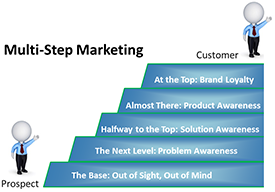
Why does this matter for marketers? It’s an excellent model for measuring where your customers are in their awareness and pinpointing areas of focus for your future marketing efforts. As with Maslow’s pyramid, each level of awareness builds on the level below it, and you can’t just skip from the bottom to the top of the mountain. What place do your customers currently hold on the pyramid, and how can you move to the next level of marketing?
The Base: Out of Sight, Out of Mind
Not everyone is in the market for what you offer, and those who aren’t conscious of an existing need are currently outside your market. That doesn’t mean they won’t have a future need you can fill or even that the needs they have don’t currently exist; they just might not know about it yet. For these prospects, your best bet is to focus on raising awareness about the need instead of focusing on the solution right away. If you’re first to market with a new product, this is the point where your marketing efforts start. Think of what the first PC manufacturers had to do to persuade people they needed a computer at home. They had to create the market before they could offer solutions to those new needs.
The Next Level: Problem Awareness
Once they’ve become aware of a problem, your prospects reach this level. Whether it’s a problem on the horizon or a pressing concern for them, your prospects don’t yet know there’s a solution at this stage. Your marketing task is to make them aware that the problem has solutions. To return to our earlier example of the nascent home computing market of the 1980s, people were acutely aware that keeping track of personal expenses was time-consuming but didn’t yet make the connection that a home computer could help. Ads of the era strove to draw that line between a known problem and an effective solution.
Halfway to the Top: Solution Awareness
At this point, your potential customer knows about the problem and is becoming aware of solutions. Prospects know what they want fixed, but not how to fix it themselves. For marketers, this step is familiar territory. The role of your marketing strategy here is to present your product or service as a solution. Most of the advertising you see addresses customers at this level.
Almost There: Product Awareness
The prospects at this level are the ones you most want to engage because they’re already knowledgeable about the issue they want to solve and the potential solutions they can seek; they’re now looking for which solution they’ll choose. Show them the benefits of selecting you over your competitors and why your product is the right choice, and you’ve earned their business.
At the Top: Brand Loyalty
The people at the apex of your marketing awareness pyramid know you offer the best solution to their problems, and your marketing challenge here is to strengthen that connection. Brand loyalty goes beyond features and benefits to become an ongoing relationship. When people trust your brand, they become ambassadors for it, spreading the message to new leads and introducing them at the bottom of the pyramid.
You can’t leap straight to asking for brand loyalty when your potential customers are still in the early stages of discovering the problem to which you can later offer the solution. There are no ladders you can climb to reach the next awareness stage early, so deliver the right message at each step to nurture those leads. When looking at your market segmentation, consider where each segment is on the awareness pyramid and tailor your message accordingly.
Contact our integrated marketing experts today at 855.867.3224 to help you devise your integrated marketing strategy.
© Reach Marketing LLC 2014 All Rights Reserved.






